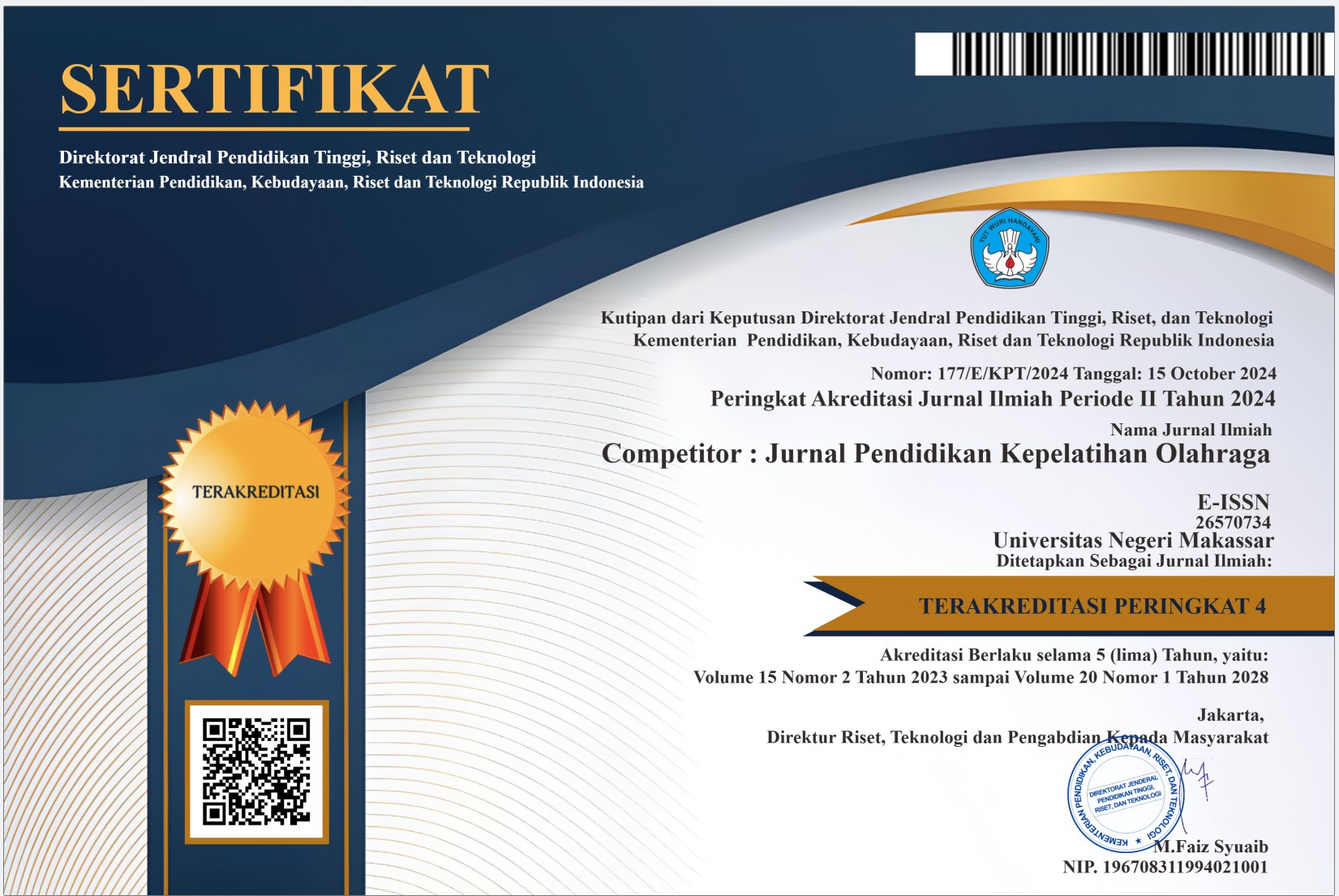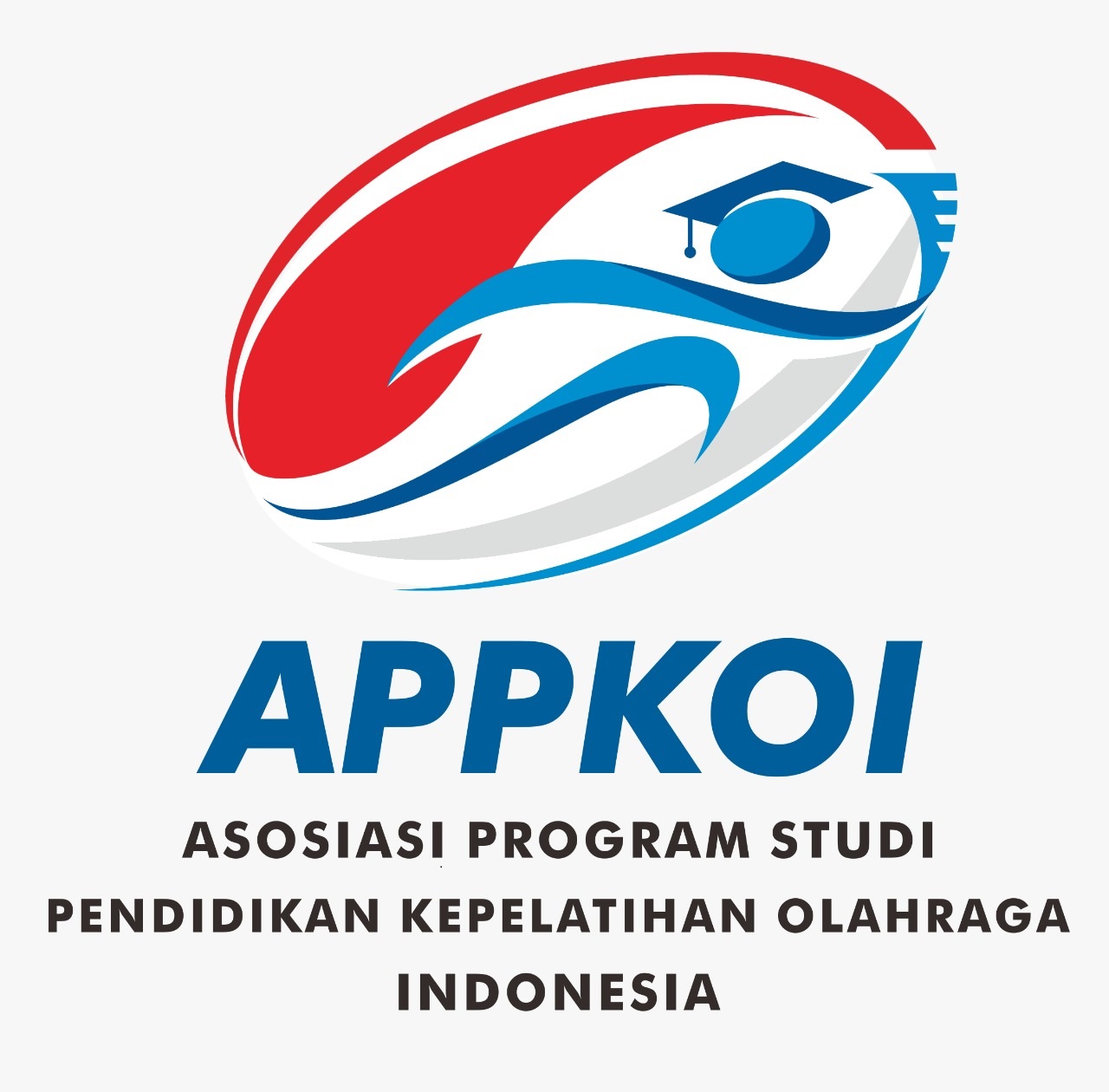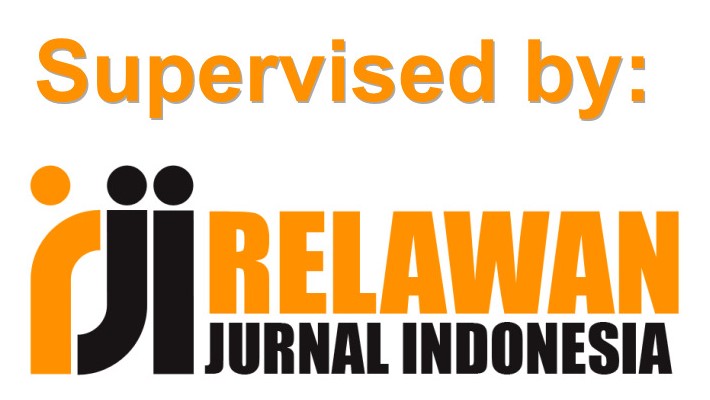Validity of Specific Leg Muscle Strength Test Instrument For Volleyball (Volleyball Squat Max Strength Test)
DOI:
https://doi.org/10.26858/cjpko.v17i2.274Keywords:
Validity; Instrument Test; Leg Muscle Strength; Volleyball; Squat Max Strength TestAbstract
This study aims to develop the Volleyball Squat Max Strength (VSMS) Test instrument, as a measuring tool for leg muscle strength in volleyball athletes at the State University of Malang, by emphasizing the validity aspect. This research used the 4D Research and Development instrument development method involving 50 volleyball athletes at the State University of Malang. The validity test includes content validity, construct validity and criterion validity. The results show that the Volleyball Squat Max Strength (VSMS) Test instrument is feasible to use according to experts and has an r count of 0.82459, which is greater than r table 0.2732, so it is declared constructively valid. For the correlation test results, r count 0.7644 is greater than r table, so it is declared to have a very high correlation with the standard instrument. This instrument is much more valid for measuring leg muscle strength than the existing instrument, the leg dynamometer, because it is more specific to the characteristics of volleyball. It should be emphasized that this study did not include reliability testing or norm setting, so these findings still require further development for wider application.
References
Arsi, A. (2021). Realibilitas Instrumen Dengan Menggunakan Spss. Validitas Realibilitas Instrumen Dengan Menggunakan Spss, 1–8.
Asiva Noor Rachmayani. (2015). Pengembangan pengujian validitas isi dan validitas konstrak: interpretasi hasil pengujian validitas. 6.
Baumgartner, TA, & J. (2017). Pengukuran untuk evaluasi dalam pendidikan jasmani dan ilmu olahraga. (Edisi Ke-8). New York: McGraw-Hill, 22, 6–9.
Borsboom, D., & Markus, K. A. (2013). Frontiers of Test Validity Theory. Frontiers of Test Validity Theory.
Briesch, A. M., Chafouleas, S. M., & Johnson, A. (2016). Use of Generalizability Theory Within K–12 School-Based Assessment: A Critical Review and Analysis of the Empirical Literature. Applied Measurement in Education, 29(2), 83–107. https://doi.org/10.1080/08957347.2016.1138955
Caldeira, P., Paulo, A., Veloso, A., Infante, J., Davids, K., & Araújo, D. (2024). How functional movement variability facilitates successful skill adaptation during the volleyball attack. International Journal of Sports Science and Coaching, 19(2), 668–676. https://doi.org/10.1177/17479541231168012
Creswell, J. W., Columbus, B., New, I., San, Y., Upper, F., River, S., Cape, A., Dubai, T., Madrid, L., Munich, M., Montreal, P., Delhi, T., Sao, M. C., Sydney, P., Kong, H., Singapore, S., & Tokyo, T. (2012). Planning, Conducting, and Evaluating Quantitative and Qualitative Research FIFTH EDITION. Education Research, 10–12.
Derick, T. R. (2015). Evaluation of time series data sets using the 18.pdf.
Doewes, R. I., Manshuralhudlori, Adi, P. W., Gontara, S. Y., Hendarto, S., Agustiyanta, Shidiq, A. A. P., & Adirahma, A. S. (2023). Pelatihan Tes Dan Pengukuran Kondisi Fisik Pada Pelatih Kota Surakarta Menuju Porprov Tahun 2023. Jurnal Widya Laksana, 12(2), 212–218. https://doi.org/10.23887/jwl.v12i2.63192
Dos Santos, E. F., Aprile, M. R., Alonso, A. C., Garcez-Leme, L. E., & Greve, J. M. D. A. (2015). Knowledge assessment instrument on basic support of hip fractures in the elderly. Acta Ortopedica Brasileira, 23(4), 215–218. https://doi.org/10.1590/1413-78522015230400976
Henriksen, K., Stambulova, N., & Roessler, K. K. (2010). Holistic approach to athletic talent development environments: A successful sailing milieu. Psychology of Sport and Exercise, 11(3), 212–222. https://doi.org/10.1016/j.psychsport.2009.10.005
Hutomo. (2020). Pengembangan Alat Bantu Latihan Untuk Bok Dalam Olahraga Bola Voli (Doctoral dissertation, STKIP PGRI Pacitan). 10–31.
Indaryanti, R. B., Murtiyasa, B., & Soemardjoko, B. (2025). 4D Research and Development Model : Trends, Challenges, and Opportunities Review. 25(1), 91–98.
Jonas Solissa. (2023). Pengembangan Instrumen Tes Daya Ledak Tendangan Dollyo Taekwondo Berbasis Teknologi. EDUKASIA: Jurnal Pendidikan Dan Pembelajaran, 4(2), 747–754. https://doi.org/10.62775/edukasia.v4i2.282
Kusumawaty, I., Achmad, V. S., Ginting, D. S., Yunike, Liana, Y., Indriyani, D., Martiningsih, W., Solehudin, & Lalla, N. S. N. (2022). Metodologi penelitian keperawatan. Purwokerto. In UPT. Percetakan dan Penerbitan UNSOED (Issue September).
Lopes, V. P., Barnett, L. M., Saraiva, L., Gonçalves, C., Bowe, S. J., Abbott, G., & Rodrigues, L. P. (2016). Validity and reliability of a pictorial instrument for assessing perceived motor competence in Portuguese children. Child: Care, Health and Development, 42(5), 666–674. https://doi.org/10.1111/cch.12359
Marpaung, H. I., & Priyonoadi, B. (2020). The Correlation between Leg-arm Muscle Power and Volleyball Players’ Open Smash Ability. 379–385. https://doi.org/10.5220/0009786803790385
Martinez, D. B. (2017). Consideration for Power and Capacity in Volleyball Vertical Jump Performance. Strength and Conditioning Journal, 39(4), 36–48. https://doi.org/10.1519/SSC.0000000000000297
Maulana, A., Basri, M. H., & Suparto, A. (2021). Hubungan Kekuatan Otot Lengan dan Berat Badan Terhadap Ketepatan Smash dalam Bola Voli di PBV . Pelopor Muda. 2021, 40–47.
Oktariana, D., & Hardiyono, B. (2020). Pengaruh Daya Ledak Otot Lengan, Daya Ledak Otot Tungkai Dan Kekuatan Otot Perut Terhadap Hasil Smash Bola Voli Pada Siswa SMK Negeri 3 Palembang. Journal Coaching Education Sports, 1(1), 13–24. https://doi.org/10.31599/jces.v1i1.82
Patrick, D. L., Burke, L. B., Gwaltney, C. J., Leidy, N. K., Martin, M. L., Molsen, E., & Ring, L. (2011). Content validity - Establishing and reporting the evidence in newly developed patient-reported outcomes (PRO) instruments for medical product evaluation: ISPOR PRO good research practices task force report: Part 2 - Assessing respondent understanding. Value in Health, 14(8), 978–988. https://doi.org/10.1016/j.jval.2011.06.013
Putri Isabella, A., & Perwira Bakti, A. (2021). Hubungan Daya Ledak Otot Tungkai dan Kekuatan Otot Lengan Terhadap Accuracy Smash Bolavola. Jurnal Kesehatan Olahraga , 09, 151–160.
Query, T., Must, F., Returned, B. E., All, W., For, P., Wno, J. O. B. N., Authors, Q. F. O. R., Query, T., Must, F., Returned, B. E., All, W., & For, P. (2010). Author queries. City, 1, 0–8. https://doi.org/10.1227/NEU.0b013e318201c293
Sattler, T., Sekulic, D., Hadzic, V., Uljevic, O., & Dervisevic, E. (2012). Vertical jumping tests in volleyball: Reliability, validity, and playing-position specifics. Journal of Strength and Conditioning Research, 26(6), 1532–1538. https://doi.org/10.1519/JSC.0b013e318234e838
Sidik, D. (2016). Dampak Penerapan “Complex Training” Terhadap Peningkatan Kemampuan Dinamis Anaerobik. Jurnal Iptek Olahraga Koni Pusat.
Villarejo-García, D. H., Moreno-Villanueva, A., Soler-López, A., Reche-Soto, P., & Pino-Ortega, J. (2023). Use, Validity and Reliability of Inertial Movement Units in Volleyball: Systematic Review of the Scientific Literature. Sensors, 23(8), 1–16. https://doi.org/10.3390/s23083960
Wijayanto, A., & Siahaan. (2022). Teknologi Metaverse dalam Ilmu Keolahragaan.
Yoga, S. P., Eka, M., & Simbolon, M. (2023). Pengukuran untuk evaluasi dalam pendidikan jasmani dan ilmu olahraga (edisi ke-8). New York: McGraw-Hill. ATHLETES PORPROV IN SPORTS PANGKALPINANG CITY MEN ’ S VOLLEYBALL Dipublikasikan Oleh : UPT Publikasi dan Pengelolaan Jurnal Universitas Islam Kaliman. 6, 66–72.
Downloads
Published
Issue
Section
License
Copyright (c) 2025 Mohamad Rizki Febrian, Nurrul Riyad Fadhli (Author)

This work is licensed under a Creative Commons Attribution 4.0 International License.





















